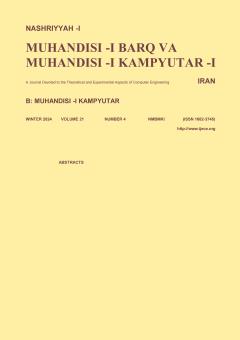Machine Learning-Based Security Resource Allocation for Defending against Attacks in the Internet of Things
Subject Areas : مهندسی برق و کامپیوتر
Nasim Navaei
1
,
Vesal Hakami
2
*
![]()
1 - IUST
2 - Iran University of Science and Technology
Keywords: Internet of things, dynamic security resource allocation, multi-armed bandit problem, machine learning,
Abstract :
Nowadays, the Internet of Things (IoT) has become the focus of security attacks due to the limitation of processing resources, heterogeneity, energy limitation in objects, and the lack of a single standard for implementing security mechanisms. In this article, a solution will be presented for the problem of security resources allocating to deal with attacks in the Internet of Things. Security Resource Allocation (SRA) problem in the IoT networks refers to the placement of the security resources in the IoT infrastructure. To solve this problem, it is mandatory to consider the dynamic nature of the communication environments and the uncertainty of the attackers' actions. In the traditional approaches for solving the SRA, the attacker works over based on his assumptions about the system conditions. Meanwhile, the defender collects the system's information with prior knowledge of the attacker's behavior and the targeted nodes. Unlike the mentioned traditional approaches, this research has adopted a realistic approach for the Dynamic Security Resources Allocation in the IoT to battle attackers with unknown behavior. In the stated problem, since there is a need to decide on deploying several security resources during the learning periods, the state space of the strategies is expressed in the combinatorial form. Also, the SRAIoT problem is defined as a combinatorial-adversarial multi-armed bandit problem. Since switching in the security resources has a high cost, in real scenarios, this cost is included in the utility function of the problem. Thus, the proposed framework considers the switching cost and the earned reward. The simulation results show a faster convergence of the weak regret criterion of the proposed algorithms than the basic combinatorial algorithm. In addition, in order to simulate the IoT network in a realistic context, the attack scenario has been simulated using the Cooja simulator.
[1] A. H. Anwar, C. Kamhoua, and N. Leslie, "Honeypot allocation over attack graphs in cyber deception games," in Proc. IEEE Int. Conf. on Computing, Networking and Communications, ICNC’20, pp. 502-506, Big Island, HI, USA, 17-20 Feb. 2020.
[2] L. Chen, Z. Wang, F. Li, Y. Guo, and K. Geng, "A stackelberg security game for adversarial outbreak detection in the Internet of Things," Sensors, vol. 20, no. 3, Article ID: 804, Feb. 2020.
[3] A. H. Anwar, C. Kamhoua, and N. Leslie, "A game-theoretic framework for dynamic cyber deception in internet of battlefield things," in Proc. of the 16th EAI Int. Conf. on Mobile and Ubiquitous Systems: Computing, Networking and Services, pp. 522-526, Houston, TX, USA, 12-14 Nov. 2019.
[4] A. Rullo, E. Serra, E. Bertino, and J. Lobo, "Optimal placement of security resources for the Internet of Things," The Internet of Things for Smart Urban Ecosystems, pp. 95-124, Jan. 2019.
[5] A. Rullo, D. Midi, E. Serra, and E. Bertino, "Pareto optimal security resource allocation for Internet of Things," ACM Trans. on Privacy and Security, vol. 20, no. 4, pp. 1-30, Nov. 2017.
[6] M. Zhu, et al., "A survey of defensive deception: approaches using game theory and machine learning," IEEE Communications Surveys & Tutorials, vol. 23, no. 4, pp. 2460-2493, Aug. 2021.
[7] A. Rullo, D. Midi, E. Serra, and E. Bertino, "A game of things: strategic allocation of security resources for IoT," in Proc. IEEE/ACM 2nd Int. Conf. on Internet-of-Things Design and Implementation, IoTDI’17, pp. 185-190, Pittsburgh, PA, USA, 18-21 Apr. 2017.
[8] M. A. R. Al Amin, S. Shetty, L. Njilla, D. K. Tosh, and C. Kamhoua, "Online cyber deception system using partially observable Monte Carlo planning framework," in Proc. Int. Conf. on Security and Privacy in Communication Systems, vol. 2, pp. 205-223, Orlando, FL, USA, 23-25 Oct. 2019.
[9] S. Wang, Q. Pei, J. Wang, G. Tang, Y. Zhang, and X. Liu, "An intelligent deployment policy for deception resources based on reinforcement learning," IEEE Access, vol. 8, pp. 35792-35804, 2020.
[10] M. Li, D. Yang, J. Lin, and J. Tang, "Specwatch: a framework for adversarial spectrum monitoring with unknown statistics," Computer Networks, vol. 143, pp. 176-190, Oct. 2018.
[11] W. Chen, Y. Wang, and Y. Yuan, "Combinatorial multi-armed bandit: general framework and applications," Proceedings of Machine Learning Research, vol. 28, no. 1, pp. 151-159, Feb. 2013.
[12] M. R. Palattella, N. Accettura, X. Vilajosana, T. Watteyne, L. A. Grieco, G. Boggia, and M. Dohler, "Standardized protocol stack for the internet of (important) things," IEEE Communications Surveys & Tutorials, vol. 15, no. 3, pp. 1389-1406, Dec. 2012.
[13] F. Algahtani, T. Tryfonas, and G. Oikonomou, "A reference implemenation for RPL attacks using contiki-NG and Cooja," in Proc. 17th Int. Conf. on Distributed Computing in Sensor Systems, DCOSS’21, pp. 280-286, Pafos, Cyprus, 14-16 Jul. 2021.

